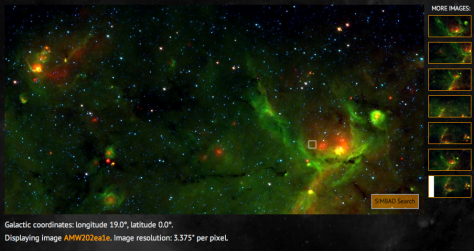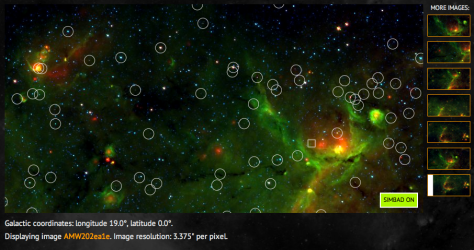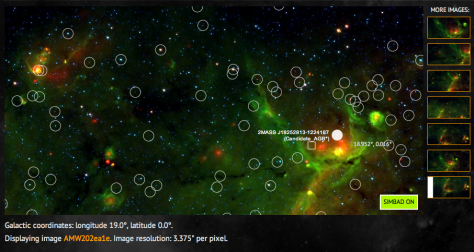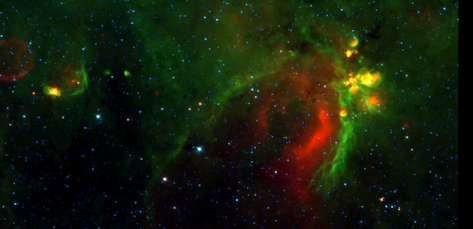
A few days ago Milky Way Project user suelaine posted an image of this pretty bubble on the Talk forum, asking whether it was a supernova. As supernovae – or rather, the debris that’s left behind after they explode – often have this kind of shape, I initially thought she was right. But when I looked up the coordinates on SIMBAD – the astronomer’s guide to the Galactic sky – I discovered it was a beautiful example of a more peculiar type of object: a Luminous Blue Variable star (LBV).
[As an aside, the SIMBAD page for the object is a little confusing, as it’s identified on there as a Be star – a rapidly rotating B star. But when you look down the page at the references, it’s clear that the star has since been identified as an LBV star, probably even more massive than originally thought.]
LBV stars are massive stars, often with a few tens of times the mass of the Sun, that are approaching the end of their lifetimes. The fuel in their cores, needed to maintain nuclear fusion, is running out. This makes them unstable, causing them to flare up at intervals. As they’re not able to hold on to their outer layers, powerful winds eject matter into the surrounding interstellar medium during these eruptions, and the star can be sen to brighten significantly over several months. LBVs are on their way to exploding as supernovae.
The evolution of such massive stars once they run out of fuel proceeds very quickly, so these objects are extremely rare: only around a dozen are firmly known in the Milky Way Galaxy. The best-known examples are Eta Carinae and the Pistol Star, perhaps the most luminous star in the entire Galaxy. Because there are so few LBVs to study, there’s a lot about them we don’t know.
This particular LBV, prosaically known as G24.73+0.69 (its galactic coordinates), was discovered in 2003, and lies at a distance of around 5 kpc, or 16000 lightyears. As well as the compact orange bubble this larger view of its surroundings shows that there is a second, larger shell, more bipolar in shape than a true ellipse. The star and its environment were studied in detail in a very recent paper by Argentinian astronomers Petriella, Paron and Giacani. They discovered a dense molecular shell tracing the outer bipolar nebula. They suggest that the inner compact bubble is the result of an LBV eruption, and the outer bipolar shell perhaps caused by more gradual mass loss during the star’s “regular” lifetime.
Interestingly, they also find evidence that perhaps new stars are forming near the lobes of the larger shell. They suggest this may be triggered star formation in the swept-up gas, but their observations can’t confirm that.
I didn’t know much about LBVs myself, so I was pretty excited with this find. Keep posting your interesting objects to the forum – perhaps we can find more LBVs or other cool types of objects.
If you’re interested in learning more about this interesting star, here’s the full paper reference:
Petriella, Paron & Giacani. The molecular gas around the Luminous Blue Variable Star G24.73+0.69. Astronomy & Astrophysics vol. 538, A14 (2012) [pdf available from Arxiv]







